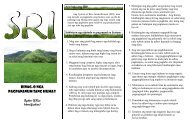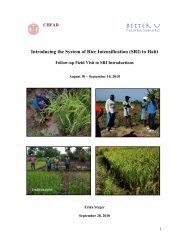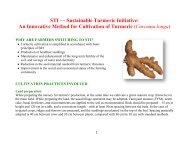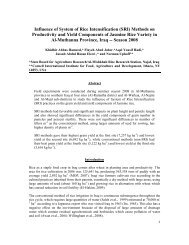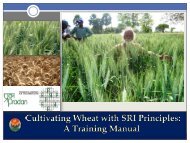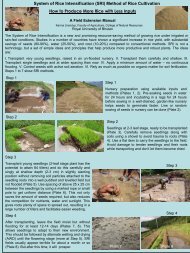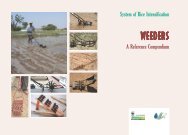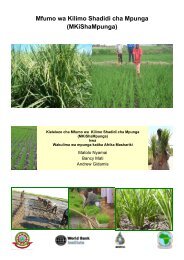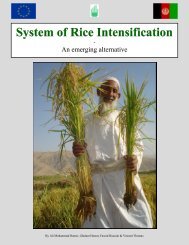EFFECT OF THE SYSTEM OF RICE INTENSIFICATION (SRI) ON ...
EFFECT OF THE SYSTEM OF RICE INTENSIFICATION (SRI) ON ...
EFFECT OF THE SYSTEM OF RICE INTENSIFICATION (SRI) ON ...
You also want an ePaper? Increase the reach of your titles
YUMPU automatically turns print PDFs into web optimized ePapers that Google loves.
high compared to other doses (see table 6). 1.9 kg m -2 corresponds to 19 t/ha which is a very large<br />
amount for small scale farmers to produce/collect and very labour intensive. Almost 50% of the<br />
farmers do however apply both compost and green manure and such a method will lead to many<br />
possibilities on finding the necessary means and amounts of amendments needed in order to reach a<br />
sustainable level of inputs.<br />
The amount of compost collected per year will cover the increase next year, but the amount of<br />
natural fertilizers collected will not be enough. Farmers only relying on natural fertilizers will need<br />
to find additional amounts of organic amendments. In theory the more compost the farmers apply<br />
the higher the yield and improved soil quality they will reach. Uphoff (1999) reports from <strong>SRI</strong><br />
practising farmers in Madagascar that amount and quality of added composts was very different<br />
from farmer to farmer and those with highest yields did also apply high amounts of compost or had<br />
a higher soil quality than other farmers. Husain et al. (2004), Mcdonald et al. (2006) and<br />
Satyanarayana et al. (2007) state that a major limitation for farmers practising <strong>SRI</strong> is the lack or low<br />
quantity of organic amendments applied to fields, which will decrease benefits of <strong>SRI</strong>. <strong>SRI</strong> can<br />
however very well be practiced with chemical fertilizers (Laulanie, 1993) but only few farmers can<br />
afford to buy these or have been encouraged by CEDAC not to use them and instead focus more on<br />
natural amendments. The farmers will through the ILFARM project receive app. 500.000<br />
multipurpose trees to plant on their homestead land and around rice fields in order to increase<br />
production of especially green manures (leaf manures). See Appendix E. Depending on which rate<br />
and amount of added compost/fertilizers farmers will somehow be forced to grow a certain area of<br />
<strong>SRI</strong>. They can choose to apply less amounts per m 2 thus reaching a larger area but with the given<br />
soil conditions (low C and N) the need for large applications is necessary in order to reach<br />
sustainable yields.<br />
9.5.5 Nutrient balance<br />
Assuming the farmers convert all their rice land to <strong>SRI</strong> and obtain average rice yields of 3.5 t/ha,<br />
and the increase in leafy manures together with increased compost production will reach an average<br />
amount of 3t/ha per year. A rough estimate of a nutrient budget could then look like the illustration<br />
in Table 8. The net balance indicate that N and P inputs are in excess but the K pool is being<br />
depleted most likely due to the removal of straw, which is typical for rice systems with removal of<br />
residues (Greenland, 1997; Dobermann & Fairhurst, 2000). However given the inputs of N, P and<br />
62



